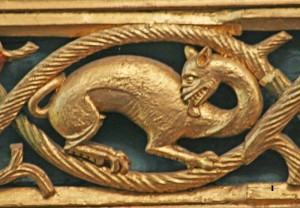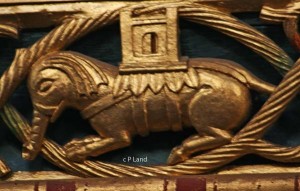Above: An animal depicting the evil of back biting. Click on this photograph for more pictures of the flowers and animals in the frieze of the Jervaulx Screen.
The medieval Jervaulx Screen is one of the most fascinating and beautiful objects at St Andrew’s church, Aysgarth. When studying it closely I can’t help wondering what those in the Ripon School of Carvers had in mind when they created some of the fabulous animals and fruits that have been included in its frieze.
By standing on the Victorian choir seats and using a 70-300mm lens I got a completely new perspective and appreciation of their craftsmanship. It is believed that the frieze was intended to impress upon the lay brethren at the Cisterician monastery at Jervaulx the perils of falling into the sins of the world such as back biting and being caught up in the snares of lust.
Even all the beautiful foliage and fantastic fruit were a warning about sin. In his essay about the Screen, which is on sale at St Andrew’s, Barry Thornton explained: “The leaves represented untamed nature and therefore Sin. The idea that nature represented God’s handiwork as in ‘All things bright and beautiful’ was a 19th century perception. In medieval times nature’s creatures were seen as red in tooth and claw, a vicious world where animal characteristics could be applied to man.’
And so the dragon, representing evil, is also shown sticking out his tongue. This was intended as a reminder that people ought to be quiet in God’s house. A creature is shown biting and therefore tasting the leaves of sin, and antelopes have their horns entangled in the bushes of sin. These would have been warnings to avoid the evils of strong drink and other sins.
To those in medieval times all the animals would have had meanings. These were so well known throughout Christian Europe that there no complete written record was made of them. So much was, therefore, forgotten once ordinary people could read the Bible for themselves and didn’t depend upon priests and craftsmen to explain or illustrate the “message”.
The barrel (tun) shown in one of the photographs of the intricate carving on the screen was the rebus (logo) of William de Heslington who became Abbot at Jervaulx in 1472. So it is possible that the screen was commissioned – as a Rood Screen – during his tenure as Abbot. This rebus was also carved on the Vicar’s Stall which is now at Aysgarth church.
For more about how the Jervaulx Screen and the Vicar’s Stall came to be at Aysgarth church see A personal view.
Below: In medieval times it was believed that an elephant had no knees and could carry a castle on its back.


We recently visited St Andrew’s when on holiday and much admired the screen and church. Your article here about the screen was a very good follow up with photographic detail. Many thanks.